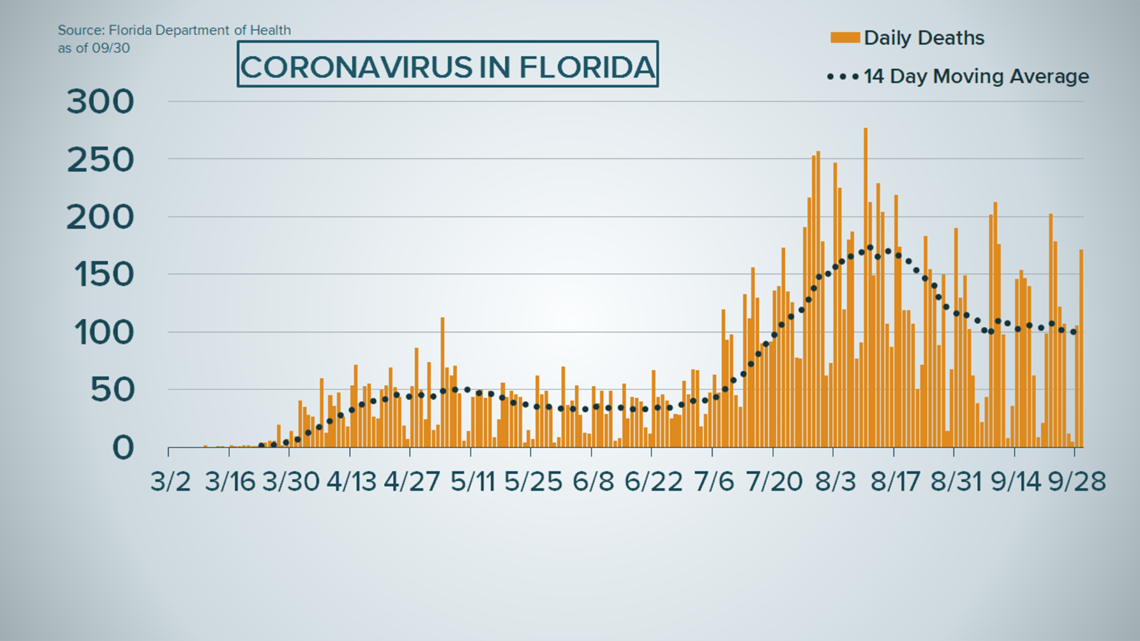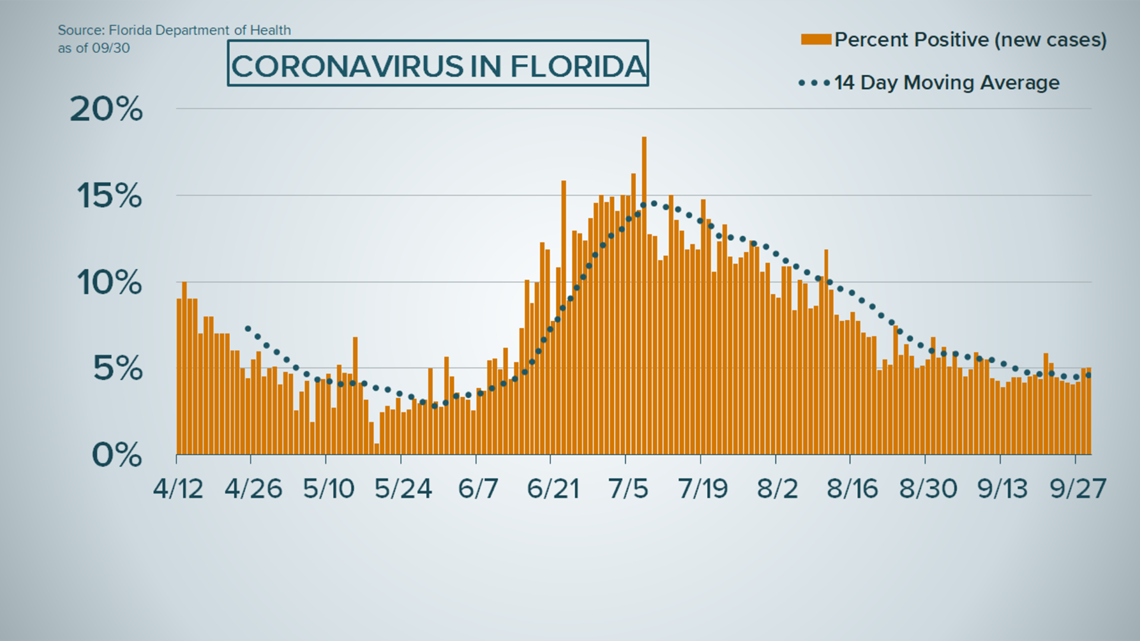Florida's daily positivity rate continues to hover around 5 percent for the past two weeks.
Wednesday's report from the Department of Health showed 5.03 percent of 44,812 test results returned from labs were positive for coronavirus.
The median age of Floridians testing positive for the virus is 41.
The positivity rate is one piece of data health experts analyze to determine how well an area is doing in combating the coronavirus and conducting tests. The World Health Organization has repeatedly said the percent positive should remain at 5 percent or lower for a 14-day span in order for further reopening to be recommended.
As for new cases, the health department reported an increase of 1,948 COVID-19 cases for Sept. 29. That brings the total to 706,516 coronavirus cases statewide since March.
Wednesday's report also showed another 172 Floridians and one non-resident had died after testing positive for coronavirus. That brings the total to 14,315 Floridians and 171 non-residents who have died from the virus since the pandemic began.


Those numbers do not necessarily mean those people died Tuesday but rather the state learned of their deaths and added the numbers to the report that day. The state's line-by-line report, which you can read here, lists coronavirus deaths by the date the people tested positive for the virus, not the date they passed.
When it comes to hospitalizations, 2,107 people were hospitalized with COVID-19 as their primary diagnosis as of 10:45 a.m. Wednesday. Of those, 507 patients were in the Tampa Bay area.
A total of 44,108 people in Florida have been hospitalized with coronavirus at some point during the pandemic.
Here's a breakdown of the new coronavirus cases reported to the state:
- June 21: 2,926
- June 22: 3,286
- June 23: 5,508
- June 24: 5,004
- June 25: 8,942
- June 26: 9,585
- June 27: 8,530
- June 28: 5,266
- June 29: 6,093
- June 30: 6,563
- July 1: 10,109
- July 2: 9,488
- July 3: 11,458
- July 4: 10,059
- July 5: 6,336
- July 6: 7,347
- July 7: 9,989
- July 8: 8,935
- July 9: 11,433
- July 10: 10,360
- July 11: 15,300
- July 12: 12,624
- July 13: 9,194
- July 14: 10,181
- July 15: 13,965
- July 16: 11,466
- July 17: 10,328
- July 18: 12,478
- July 19: 10,347
- July 20: 9,440
- July 21: 9,785
- July 22: 10,249
- July 23: 12,444
- July 24: 12,199
- July 25: 9,344
- July 26: 8,892
- July 27: 9,230
- July 28: 9,446
- July 29: 9,956
- July 30: 8,989
- July 31: 9,643
- August 1: 7,104
- August 2: 4,752
- August 3: 5,446
- August 4: 5,409
- August 5: 7,650
- August 6: 7,686
- August 7: 8,502
- August 8: 6,229
- August 9: 4,155
- August 10: 5,831
- August 11: 8,109
- August 12: 6,236
- August 13: 6,148
- August 14: 6,352
- August 15: 3,779
- August 16: 2,678
- August 17: 3,838
- August 18: 4,115
- August 19: 4,555
- August 20: 4,684
- August 21: 4,311
- August 22: 2,974
- August 23: 2,258
- August 24: 2,673
- August 25: 3,220
- August 26: 3,269
- August 27: 3,815
- August 28: 3,197
- August 29: 2,583
- August 30: 1,885
- August 31: 7,569 (Quest Diagnostics backlog)*
- September 1: 2,402
- September 2: 3,571
- September 3: 3,198
- September 4: 3,656
- September 5: 2,564
- September 6: 1,838
- September 7: 1,823
- September 8: 2,056
- September 9: 2,583
- September 10: 3,650
- September 11: 3,190
- September 12: 2,423
- September 13: 1,736
- September 14: 3,116
- September 15: 2,355
- September 16: 3,255
- September 17: 3,204
- September 18: 3,573
- September 19: 2,521
- September 20: 1,685
- September 21: 2,470
- September 22: 2,590
- September 23: 2,541
- September 24: 2,847
- September 25: 2,795
- September 26: 1,882
- September 27: 738
- September 28: 3,266
- September 29: 1,948


Breaking down the numbers
For the month of August, daily reported COVID-19 cases in Florida remained under 10,000. And, for more than a week, daily new cases were under 4,000.
That changed with the report for Aug. 31. A backlog* of nearly 75,000 test results from Quest Diagnostics was added to that day's report, which resulted in 7,569 new cases reported. Failure to report those test results earlier, most of which were more than two weeks old, with some dating all the way back to April, caused the Department of Health to sever all ties with Quest, according to the state.
Florida on Aug. 22 became the second state to cross the 600,000 reported COVID-19 cases mark. As of Sept. 24, California has had more than 796,000 cases. Texas has more than 742,000 cases, according to Johns Hopkins University & Medicine.
Since Sept. 1, daily reported COVID-19 cases have stayed below 4,000.
On Aug. 31, the United States passed 6 million coronavirus cases, the highest recorded number in the world, according to the Associated Press. That's a little more than three weeks after the country surpassed 5 million confirmed coronavirus cases on Aug. 9.
The highest single-day case number Florida has reported so far is 15,300 for July 11. The lowest single-day case number the state has reported since early June is 738 confirmed on Sept. 28.
Florida has not reported a single-day new case number at or higher than 10,000 since late July.
The state's report released on Aug. 11 of 277 newly confirmed deaths was the highest seen from the state in a single day's report.
The state recently added a section to its daily report (on page 5) that shows deaths by date of death. This data has been reported daily on Florida's COVID-19 dashboard. The graph for deaths by date of death is subject to change, though, because the information reported to the state can be delayed up to two weeks. So, for consistency, our charts have stuck to new deaths added by the date they were added. For transparency, you can always reference the state's data here.
The positivity rate is crucial for reopening. The World Health Organization has repeatedly said it must remain at 5 percent or lower for a 14-day span for the agency to recommend reopening.
However, it can be somewhat misleading: The number of people tested statewide varies each day, and the percent positives have ranged from a high of near 7 percent and a low of under 5 percent recently. Health officials say they would like to see a high -- but steady -- number of people tested every day and a suppressed percent positivity figure.
Until Aug. 21, Florida had not seen a positivity rate at 5 percent since the beginning of June. In July, the state reported positivity rates at double and even triple that recommended percentage.
The reports for Aug. 1 and 2, respectively, showed positivity rates below 10 percent for the first time since June 24. In August, the state reported a positivity rate above 10 percent five times.
The positivity rate reported for Sept. 13 (3.91 percent) is the lowest Florida has seen since mid-June.
On Friday, Sept. 25, Gov. Ron DeSantis announced the state could move into what was initially called "Phase 3" of its reopening plan. DeSantis signed an order guaranteeing restaurants the right to operate and lifting state-level capacity restrictions on them.


Hospitalizations and ICU bed availability
New cases have dropped significantly in recent months, but what about hospitalizations?
Tracking hospitalizations got easier on July 10 when the Agency for Health Care Administration began publishing a spreadsheet with the number of people currently checked-in for coronavirus-related complications in Florida. The data only includes people whose "primary diagnosis" was COVID-19.
As of 10:45 a.m. Wednesday, 2,107 people were hospitalized with COVID-19 as their primary diagnosis statewide, and 507 of them were in the Tampa Bay area. Those numbers are frequently updated, and you can click here for the most recent data, which is also broken down by county.
Since the pandemic began, the state confirms a total of 44,108 residents were hospitalized at some point during their illness.
The Agency for Healthcare Administration (AHCA) also updates total hospital bed and ICU availability by county.
Click here for a breakdown of adult and pediatric ICU bed availability by county. You can also check ICU availability by the hospital.
Hospitalizations around Tampa Bay and total staffed hospital bed capacity status:
**Data as of 10:45 a.m. a.m. Sept. 30
Citrus:
- 17 COVID-19 hospitalizations
- 78 of 313 total staffed hospital beds are available
DeSoto:
- 0 COVID-19 hospitalization
- 47 of 55 total staffed hospital beds are available
Hardee:
- 0 COVID-19 hospitalizations
- 2 of 25 total staffed hospital beds are available
Hernando:
- 24 COVID-19 hospitalizations
- 215 of 738 total staffed hospital beds are available
Highlands:
- 24 COVID-19 hospitalizations
- 35 of 250 total staffed hospital beds are available
Hillsborough:
- 161 COVID-19 hospitalizations
- 537 of 3,806 total staffed hospital beds are available
Manatee:
- 25 COVID-19 hospitalizations
- 115 of 770 total staffed hospital beds are available
Pasco:
- 40 COVID-19 hospitalizations
- 169 of 1,348 total staffed hospital beds are available
Pinellas:
- 96 COVID-19 hospitalizations
- 922 of 3,253 total staffed hospital beds are available
Polk:
- 87 COVID-19 hospitalizations
- 354 of 1,652 total staffed hospital beds are available
Sarasota:
- 33 COVID-19 hospitalizations
- 181 of 1,232 total staffed hospital beds are available

